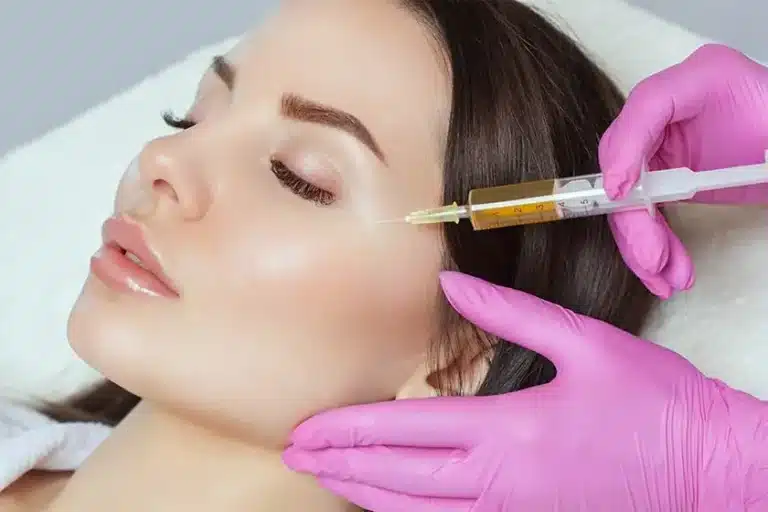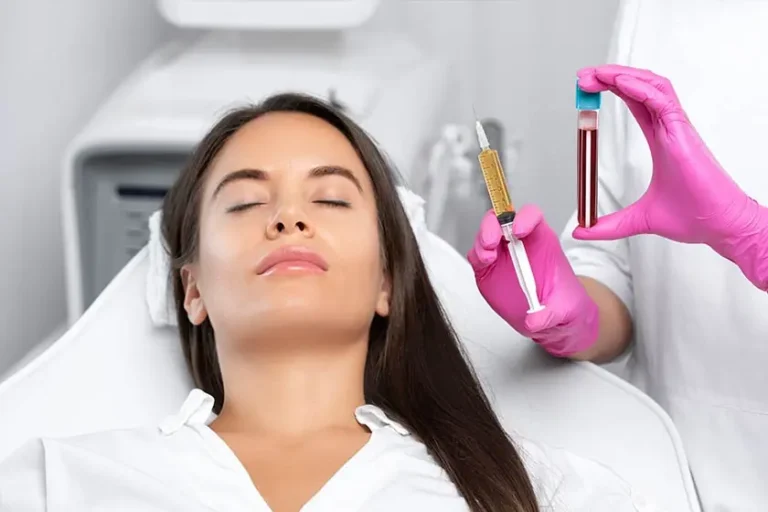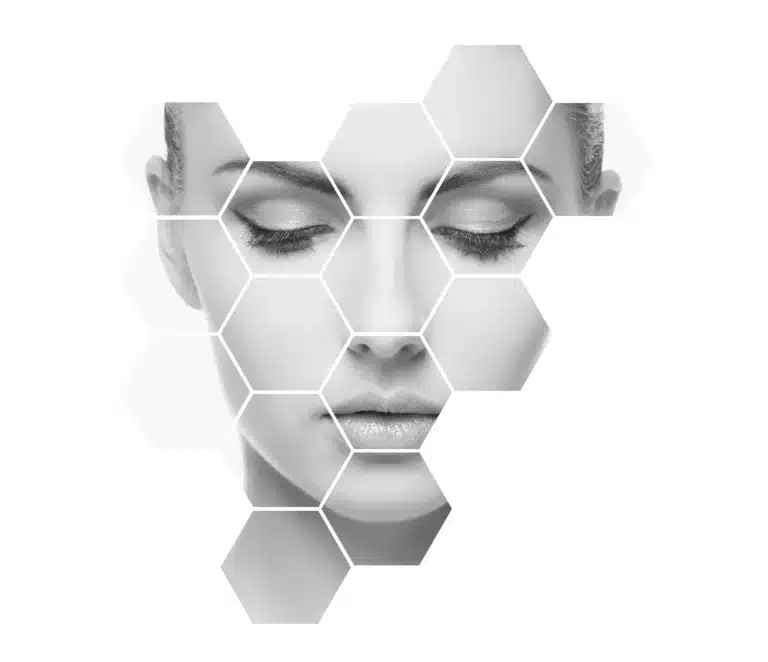Home » Solutions » Injections » PRP injections
PRP is a natural, autologous treatment that consists of injecting plasma (the liquid part of the blood) enriched with platelet growth factors. This product is obtained by centrifuging the patient's blood. The goal of the treatment is tissue regeneration.
PRP, or Platelet-Rich Plasma, is a medical technique that provides natural and effective results for skin regeneration and hair revitalization.
During a PRP session, a small amount of the patient's blood is collected and centrifuged to separate the plasma rich in platelets and growth factors.
PRP is injected using the mesotherapy technique.
Facial PRP treats signs of
aging on the face and neck, such as wrinkles and fine lines, stimulates collagen production, and improves skin elasticity without surgery. It acts like an anti-aging serum. What is PRP for hair? PRP for hair is used to stimulate hair growth and combat hair loss.
The Vampire Lift is an innovative aesthetic medicine procedure that uses the regenerative power of platelet-rich plasma (PRP) to rejuvenate and revitalize the skin. This treatment gets its nickname from the fact that it involves using the patient’s own blood to obtain PRP.
During the session, a small amount of blood is drawn, centrifuged to isolate platelets rich in growth factors, and then reinjected into the face to rejuvenate the skin.
The results of this procedure include stimulation of collagen production, improved skin texture, wrinkle reduction, and enhanced natural radiance.
This technique is effective in making the skin look younger and more radiant. Thanks to its lasting effects and natural approach, the Vampire Lift has quickly become one of the most popular facial rejuvenation methods.

Platelet-Rich Plasma (PRP) injections rely on the regenerative and healing properties of platelets. These release growth factors that activate the skin's regeneration mechanisms.
On the face, PRP stimulates the production of collagen and elastin, two essential components of the dermis.
On the scalp, PRP acts by stimulating the stem cells of hair follicles, improving blood circulation, and creating an environment conducive to hair regrowth.
There are various solutions for skin rejuvenation and hair growth stimulation. PRP (Platelet-Rich Plasma) and mesotherapy differ in their approaches and outcomes.
Le PRP utilise les propriétés régénératrices du sang du patient pour stimuler la production de collagène et d’élastine, ce qui améliore la texture et la luminosité de la peau. La mésothérapie consiste à injecter un mélange de vitamines, minéraux et autres agents revitalisants directement dans le derme pour hydrater la peau en profondeur.
PRP is particularly effective for treating signs of aging and promoting cellular regeneration. Mesotherapy is preferred for its immediate hydrating effects and its impact on skin tone. These two techniques can complement each other to provide optimal results depending on each patient's specific needs.

PRP stimulates tissue regeneration, and the differentiation and proliferation of stem cells.
The aesthetic indications are :

The contraindications are :

The PRP (Platelet-Rich Plasma) session begins with a consultation with the doctor to assess the patient’s needs and expectations. Then, a small amount of blood is drawn from the patient’s arm, just like a standard blood test.
The tube used is a medical device certified for use in Switzerland, Europe, and the United States.
The tube containing the blood is then placed in a centrifuge to separate the blood components and isolate the plasma rich in platelets and growth factors.
The PRP is then collected. The treatment area is disinfected.
Multiple injections are made into the dermis using a mesotherapy injection gun. The session is painless.
The initial treatment plan includes three sessions spaced one month apart. Maintenance treatment involves two sessions per year.
Les résultats du traitement PRP pour les cheveux sont encourageants. Les patients observent une réduction de la chute dès les premières séances et une repousse de cheveux plus forts et épais au fil du temps. Comme le cycle pilaire est assez long, les résultats sont visibles trois mois après la séance et optimales à six mois. Les effets peuvent durer jusqu’à un an ou plus. Pour conserver les résultats, des séances d’entretien sont à prévoir. Le PRP est particulièrement efficace pour les personnes souffrant d’alopécie androgénétique ou d’amincissement des cheveux lié au stress ou à d’autres facteurs.
For rejuvenation, patients describe smoother, softer, and younger-looking skin after several sessions.
The benefits include improved skin elasticity, a more radiant complexion, reduced fine lines, and denser skin on the face, neck, décolleté, and hands.
The first results are generally visible after a few weeks, with progressive improvement over several months. Maintenance sessions are recommended.

PRP is an autologous product (taken from and reinjected into the same patient), so side effects are minimal and there is no risk of disease transmission.
This treatment is safe and well tolerated, but like any procedure, it may have side effects. Patients may experience mild pain or sensitivity at the injection sites. Redness, bruising, or slight swelling may also occur after treatment. These effects are moderate and resolve within a few days.
It is important to mention any medication intake, as some adverse reactions have been observed when taking certain drugs, particularly Roaccutane.
The price of a PRP (platelet-rich plasma) session in Geneva is 600 CHF. This price includes the entire procedure : blood draw, centrifugation, preparation of the platelet concentrate, and reinjection.
PRP treatment is based on using the patient’s own growth factors, extracted from their blood.
The rate remains fixed per session, regardless of the injection site (scalp, face, neck, or décolleté). Depending on the indication (hair loss, improved skin texture, mild skin laxity), several sessions may be recommended, usually spaced 3 to 4 weeks apart. A personalized protocol is defined during the initial consultation.
The 600 CHF price thus reflects not only the technical precision of the procedure and the equipment used (special PRP collection tube, centrifuge, specific needles), but also the medical expertise required to ensure a safe and effective autologous treatment.
PRP injections in Switzerland cannot be performed by a nurse.
Reviews of PRP for hair loss are positive. Many patients report a noticeable improvement in hair density and quality after a few sessions. They particularly appreciate using their own blood. However, results may vary from person to person, and several sessions are often necessary to observe significant improvements. Overall, patient satisfaction is high.
Les avis sur le PRP pour le rajeunissement de la peau sont également positifs. De nombreux patients notent une amélioration significative de la texture et de la fermeté de la peau, ainsi qu’une réduction des rides et des ridules. Les patients apprécient le caractère naturel et autologue de ce traitement. Les résultats sont variables, comme pour tout traitement, mais la majorité des patients exprime une satisfaction élevée, soulignant l’absence d’éviction sociale et les bénéfices progressifs observés au fil des séances.
PRP is an option for patients who wish to improve skin texture, reduce the signs of skin ageing or stimulate hair growth. A prior consultation will determine the most appropriate treatment protocol.
The number of sessions required depends on the pre-set objectives and the patient's individual response.
As an initial treatment, we recommend 3 sessions spaced 6 weeks apart. An annual session is required to maintain the benefits of the treatment.
PRP is not painful, although some people may experience slight discomfort or tingling during the injections. An anaesthetic cream may be applied for the patient's comfort, but this is not recommended as the anaesthetic may interfere with the PRP.
The results of PRP appear gradually, with a visible improvement in skin texture and hair growth after a few weeks. Optimal results are visible a few months later.
Yes, PRP is a safe treatment because it uses the patient's own blood. It is important to consult a qualified doctor to ensure the safety and effectiveness of the treatment.
The advantages of PRP treatment are :
Yes, PRP is effective for :
PRP (Platelet Rich Plasma) treatment must be carried out by an experienced doctor such as a dermatologist, aesthetic doctor or plastic surgeon. These professionals have the necessary training to carry out this treatment safely and effectively. Any doctor who has been trained in this procedure can carry it out.
PRP is injected either by hand, using a very fine needle, or with a mesotherapy gun.
It is generally advisable to wait at least 24 hours before washing the face after a PRP treatment. This allows the PRP to penetrate properly and work effectively.
Les effets du PRP varient d’une personne à l’autre. Les premières améliorations dans la texture et l’aspect de la peau sont visibles quelques semaines après le traitement.
In the case of hair, a reduction in hair loss and regrowth can be observed after a few months.
Après un traitement PRP, il est recommandé d’utiliser une crème hydratante douce et sans parfum. Les crèmes contenant de l’acide hyaluronique sont recommandées. Il faut évitez les produits contenant des rétinoïdes ou des agents exfoliants pendant au moins une semaine.
Éviter les anti-inflammatoires non stéroïdiens (AINS) comme l’ibuprofène, certains compléments alimentaires et la vitamine C quelques jours avant la procédure. Informez votre médecin de tout médicament ou supplément que vous prenez.
After a PRP treatment, try to sleep on your back to avoid the product present on the skin, and which will penetrate completely during the night, being absorbed by the pillowcases .
Après un traitement PRP pour les cheveux, utilisez un shampoing doux et sans sulfate pour éviter toute irritation du cuir chevelu. Attendez au moins 24 à 48 heures avant de laver les cheveux pour permettre au PRP d’agir efficacement.
PRP stimulates hair growth by increasing blood flow to the hair follicles and improving collagen production. Many patients experience a reduction in hair loss and regrowth, the extent of which varies from patient to patient, after several PRP treatments.
Le PRP peut ne pas fonctionner pour certains patients en raison de plusieurs facteurs, tels que des conditions médicales sous-jacentes, un stade avancé de perte de cheveux ou une mauvaise réponse individuelle au traitement. Il est important d’avoir des attentes réalistes et de discuter de ces facteurs avec votre médecin pour déterminer si le PRP est une option viable pour vous.
You can resume your usual activities immediately after the session. You should avoid washing your hair and sweating for 24 hours.